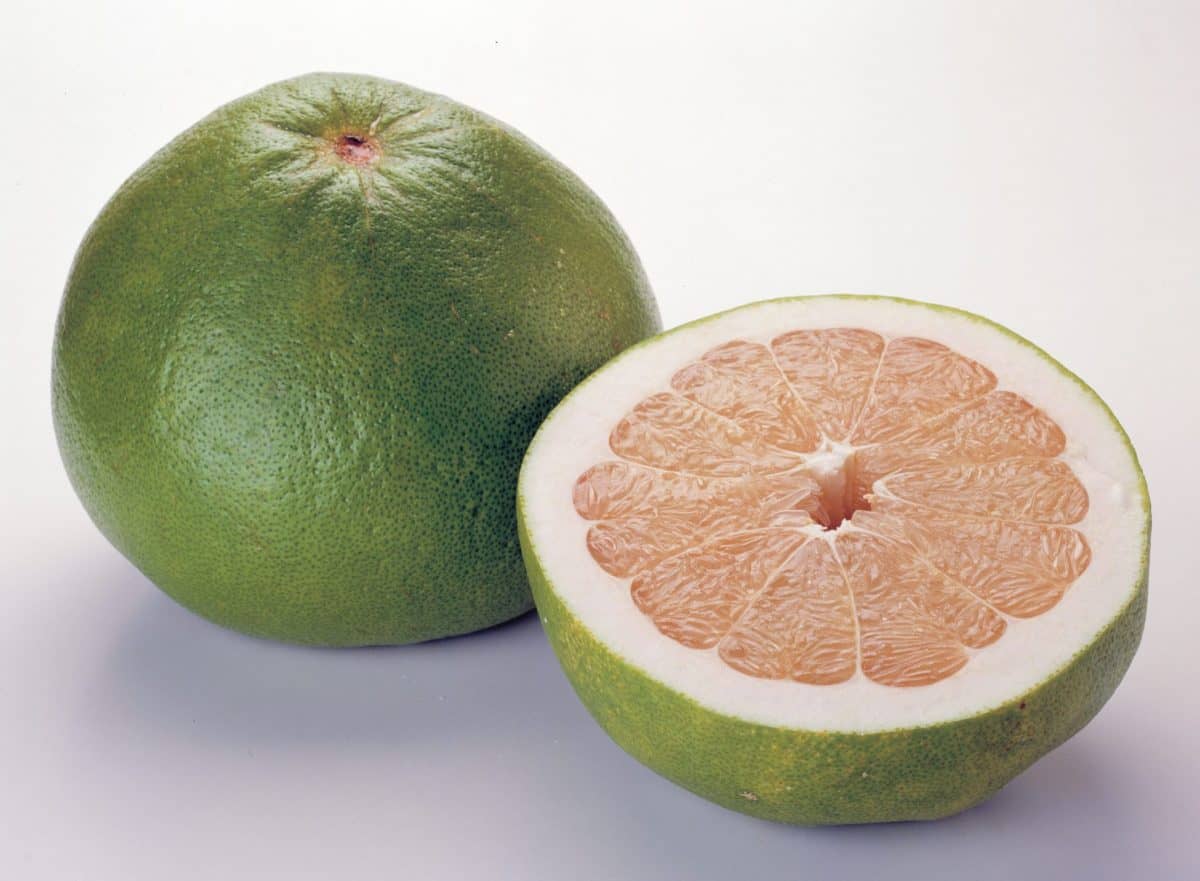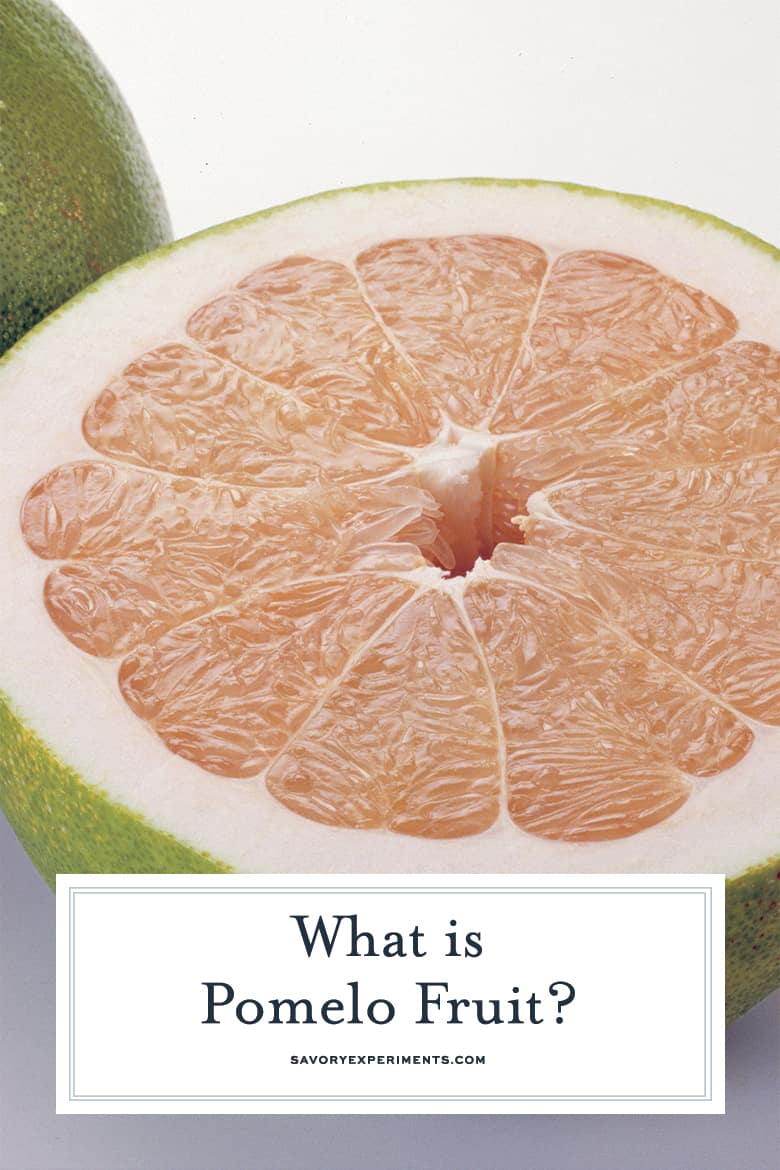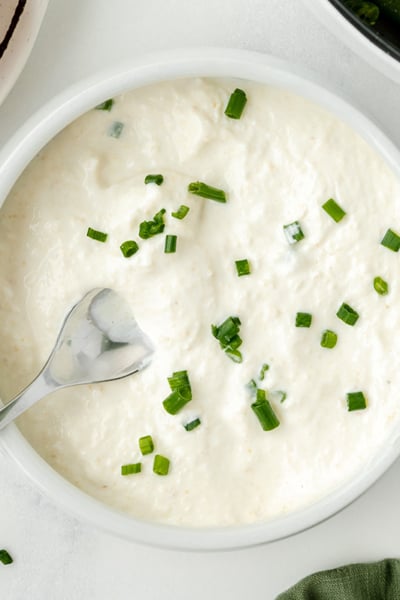Pomelo is large, gorgeous citrus (and I do mean large – they are bigger than any other citrus fruit) with skin that can vary in color from green to yellow and everything in between. Some fruits are perfectly round in shape while some lean more toward a pear shape.

What is Pomelo?
The average pomelo weighs 2-4 pounds, but they can grow up to 25 pounds!
Beneath the vibrant skin is a layer of pith which can be more than an inch thick. The flesh can vary just as much as the thick rind with some touting a pink hue while others are white or even orange.
They sometimes go by other names such as shaddock, Bali lemon, Chinese grapefruit, Citrus maxima or Citrus grandis (because they are enormous). They are largely produced in Southeast Asia and West Indies from the pummelo tree.
My Evolution to New Fruits
This is a somewhat embarrassing admission: Growing up, I was not a very adventurous eater and when it came to citrus, I wanted nothing to do with it. To me, it was unpleasant.
As I got older, this attitude started to shift and when I realized all that I had been missing out on, it almost became a personal challenge to try anything and everything.
One of the most memorable discoveries was at a night market on a trip to Thailand. These mini-cities are thriving with people, prepared food stalls, restaurants with ten seats, and an abundance of fresh fruits and vegs (among many other things.)
After procuring some mangosteen (a story for another time,) my eyes gravitated toward a pile of massive green globes. I nabbed one, not 100% sure what it was, to eat in the morning. After a quick google, I took my first bite of pomelo and was immediately hooked.
Pomelo Taste
What does pomelo taste like?
Pomelo has a sweet and sour taste much like a grapefruit without the bitter aspect, like a sweet orange. They have a floral aroma. They tend to be less juicy than some of their citrusy counterparts.
Fun fact: The big citrus trees are native to Southeast Asia and what is particularly interesting about them, is that they are one of the few non-hybrid fruits that we eat today. The other two non-hybrids are lemons and mandarins. They grow on pomelo trees.
Crazily enough, all other citrus is based on creating hybrids between these three and then hybrids of those things.
How To Eat Pomelo
Pomelo is delicious raw, but given its size, it might seem hard to manage. There are many ways to tackle a pomelo, but if you want to make your life easy, follow one of these methods. This will help a somewhat daunting arduous task seem so much easier.
Version 1: Supreme it! You can cut a pomelo by using the top and tail a bit so that it will sit flat on the cutting board. Using a sharp knife, work in sections to cut away the skin and pith following the natural curve of the fruit. Just like you would trying to supreme a lime, lemon or orange for a salad.
When that is gone, hold the flesh in your hand and use a knife to cut between the membranes to release the segments. There you go. Beautiful slices with no pith or white membrane.
Version 2: Score the skin! You can peel a pomelo using a small paring knife, score the fruit from top to bottom, cutting only so deep that you feel the flesh. Do this three more times to create an “x” shape on the fruit. Use your hands to peel away the peel and pith.
What is left should look like what you have when you eat an orange. From there, peel each segment and enjoy! You’ll have some white membrane, but it is edible, just not as pretty.
If you are feeling adventurous, do as they do in Thailand and give that fresh pomelo a sprinkle of coarse salt and a quick hit of chili powder. Or take another route and toss them into a fresh salad.
How Do I Cook With Pomelo?
It can be used much like you would use any other form of citrus fruit. The flesh is great for fresh salsas, marinades, jams. The juice is wonderful in citrusy vinaigrettes and for cocktails.
The peel can be zested and used in jams or candied for a bright and tart treat.
Really anything that calls for grapefruit, orange, lime or lemon can also be substituted with pomelo.
Health Benefits of Pomelo
One pomelo boasts a few days worth of vitamin C and is packed with potassium as well. They are also rich in antioxidants as well as fiber. They are cholesterol-free, fat-free, and low in sodium.
Because of this, they have been linked to:
- Lowered blood pressure
- Reduced weight
- Lowered risk of certain cancers
- Better heart health
- Powerful antioxidant
- Reducer of free radicals
- Strengthens immune system
What Can I Substitute for Pomelo?
If you can’t find pomelo, grapefruit is going to be the next best thing to use in a recipe. It will be a little bit more bitter and have a bit more water than the pomelo would, but the flavor profiles are similar enough that it will work well in a pinch. But you can use any other citrus as well.
Where do I buy Pomelos?
Many grocery stores have them, you’ve just never noticed. There is usually an end cap in the produce section that has more exotic fruits. Dragon fruit, passion fruit, star fruit, jackfruit- those types. Pomelos aren’t as pretty and interesting as those and often get looked over. You can find them there.
They might also be labeled as a Florida Pomelo. That is good too- same fruit, just grown and harvested in our most tropical of states either Florida or California, instead of being imported from Thailand.
Asian markets stores also commonly carry them.
Most Frequently Asked Questions:
They taste much like grapefruit, but each individual fruit will vary slightly in tartness, sweetness and bitterness. They have juicy cells just like other citrus fruits.
Similarly, yes, you can eat the fruit inside, but not the membrane. Eat is raw or chop it up for salsa, salad or sauces. It can be caramelized on the grill or made into jams and spreads.
Pick it up, it should feel heavy and not have any soft spots or bruises. Give it a sniff test, when ripe, it will smell sweet.
You can store pomelos at room temperature for up to 5 days and in the fridge for up to 2 weeks.
You might also enjoy:



















Love pomelo season! They’re so tasty.
Oh man, I can’t believe people are missing out on pomelo! I love Asian pomelo, it’s the perfect amount of sweet and sour!
I had never heard of Pomelo before! I am going to look for this and make a fresh vinaigrette with it!
Oh, that would be delightful! A little tart and sweet, but totally fresh!
This is so helpful and informative! Thanks for sharing!
I absolutely LOVE pomelo! Just wish it wasn’t such hard work peeling them! LOL! I think our palate matures as we age so tend to be more open to trying new foods even though we may not have been so adventurous when we were young. As any Brussels sprouts eater now if they ate Brussels sprouts when they were kids and I would almost everyone would say no!
I totally agree- this, nor grapefruit, interested me when I was younger, but now, bring it on!
Such an informative post! Thank you!!